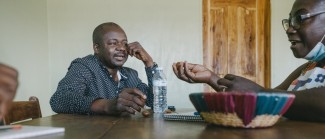The past two years have been a rollercoaster as COVID-19 and climate change challenged global, national and local systems and traditions. The war in Ukraine, an event no longer expected in post-world war Europe, and its dire impacts in countries far away from the warring parties, is adding stress, complexity and growing uncertainty to the already challenging international landscape.
In this context, the importance of partnerships cannot be underestimated as no one, or group alone can tackle the immensity of the challenge.
This is not a new idea. In 2011, the OECD Global Partnership for Effective Development Cooperation was created with the Busan Partnership Agreement. However, with the threat of the triple Cs – COVID-19, climate change and conflict – the partnership principle is picking up speed. COP26 has seen more joint initiatives than ever before, and the Doha Programme of Action for Least Developed Countries describes itself as a global partnership that includes the UN, multilateral institutions, regional development banks, least developed countries (LDCs), the private sector, and civil society.
Even the trade community is feeling the partnership push. Historically, trade was considered as a separate world operating independently from development. The idea of development in multilateral trade was often reduced to the principle of special and differential treatment, which exempts developing countries from certain obligations imposed by the trade regime. But recently, trade and trade policy have been forced to reconsider their interconnection with development, environmental and social issues. For example, the WTO fisheries subsidies negotiations would be the first agreement – if achieved – that would aim to protect the environment in addition to regulate fisheries.
In practical terms, trade must now be addressed in the wider context of economic development and related financial and regulatory frameworks but also take into consideration the interaction of trade with social, environmental, and political issues, including health disasters, climate change and conflict. This is where the notion of partnership comes in. And to meet the increasing urgency for more action and real change, we must look at and build on any potentially existing examples from the past decades of international development. Even in view of rapid change, good practice is never outdated.
Combining multilateralism with partnership and country leadership, the Enhanced Integrated Framework (EIF) can serve as one of these examples on how to build the collaboration and connections needed to successfully leverage trade to create a positive impact for those most in need.
Originally born out of a desire by WTO members to better integrate LDCs into the new global trade system in 1997, the EIF has, over the years, become a flagship platform for cross-sectoral partnerships between trade and development actors to support LDCs build trade institutions, knowledge, capacities and technologies.
With EIF partner support, many of the LDCs have not only strengthened their economic outputs but also became more active partners in regional and global trade. For example, a doubling of EIF support was linked to around a 20% increase in total exports of LDCs with stronger economies having average and above-average export volume. In comparison, a doubling of total Aid for Trade was found to be associated with a 4.7% increase in total trade – exports and imports of goods and services – of Aid for Trade recipients.
But the impact of the partnership goes beyond trade and economic development, as many interventions have a clear aim to enhance environmental and social protection. For example, EIF projects supporting honey and shea butter production in Zambia and Uganda respectively had important side effects on environmental sustainability and climate change mitigation.
The 2022 Evaluation of the EIF recognises that one of the key principles at the heart of the success of the EIF model is partnership. EIF partner interventions in a country start with government buy-in and build on collaborative approaches between international, national and local partners. This mix ensures not only a comprehensive, coherent approach to local problems but also sustainability and scaling up achievements and lessons learned.
Here is what we have learned about partnerships:
Partnerships are not static
Partnerships are not static, and like any relationship, they evolve. As the evaluation points out, regular review of mandates, division of labour and related structures within the partnership are critical to ensure common expectations and strategic use of the comparative advantage and added value offered by each of the partners.
A good example is the EIF Empower Women Power Trade Initiative, which seeks to transform the economic lives of women in LDCs. Close collaboration allowed the EIF partners ITC, UNCTAD, UNDP and the World Bank to strengthen their relationship amongst each other and with beneficiary governments, thereby helping to mainstream gender aspects into trade and trade policy. It also opened avenues for new partnerships with ITU, East African Women in Business Platform, Fairtrade Australia and leverage additional resources and technical expertise.
As the partnership welcomes new partners or addresses new thematic issues, a reflection needs to happen at the governance level to review at which juncture the partnership currently stands and the best ways to make it more effective to meet its objectives.
The partnership needs to see itself as collectively responsible for delivering this mission, with a clear definition of respective roles and the division of labour. And this involves constantly reviewing its mandate and adapting the division of labour to reflect changes.
Partnerships need a broker
Achieving measurable change in the often complex and politically sensitive trade-related technical assistance ecosystem in and around LDCs requires not only close global, but also national and local coordination and collaboration.
Partnerships are complex and brokering them in an interconnected, yet siloed, world is becoming ever more important to promote a collaborative mindset, skills, openness for dialogue and flexibility from all partners.
However, as with any broker function, this requires the confidence and trust from key constituencies to recognise the value of the partnership, as well as each partner's contribution to the whole. Promoting a collaborative mindset and skills on the part of the broker, but all the partners, also is key.
Tackling current world challenges through partnerships also requires us to leave the old ways of working behind and embrace collective action where results and successes trump individual goals and concerns.
As the late Steve Jobs said, "Great things in business are never done by one person; they’re done by a team of people.” Today's world does not allow us to ponder the need or effectiveness of partnerships but requires us to accelerate and perfect our efforts to partner with others in support of the poorest and most vulnerable but also for the benefit of all of us. The series of global meetings and events in 2022, including the WTO Ministerial Conference, Aid for Trade Review and COP27, offer unseen opportunities to put words into action. Let's not miss it.
---
This article is part of the EIF Evaluation Series, looking at 10 years of impact from the EIF partnership in least developed countries.
If you would like to reuse any material published here, please let us know by sending an email to EIF Communications: eifcommunications@wto.org.



